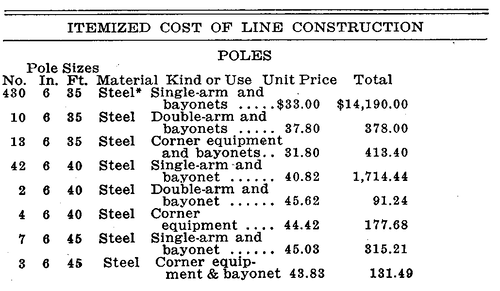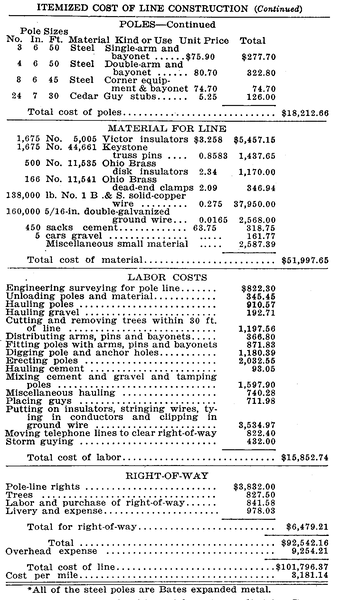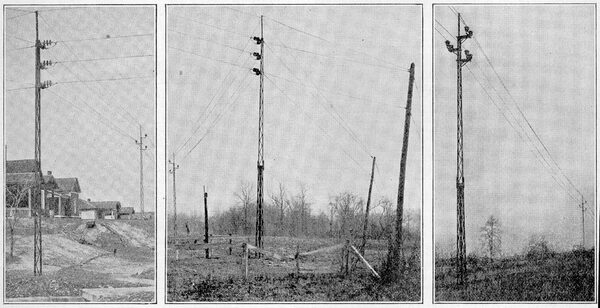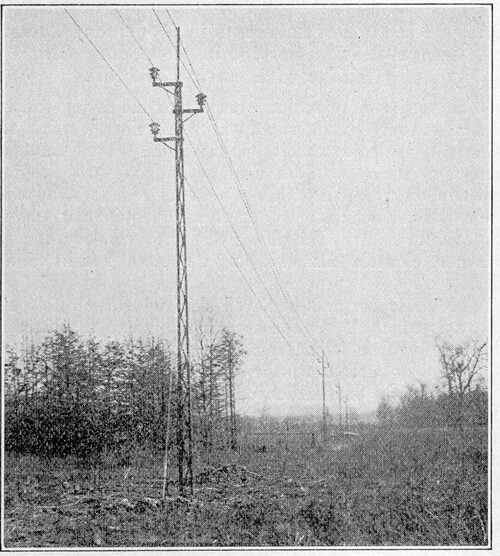[Trade Journal]
Publication: Electrical World
New York, NY, United States
vol. 74, no. 15, p. 798-9, col. 1-2
Cost of Building a 33,000-Volt Line
Steel-Pole Line 32 Miles in Length, Equipped with No. 1 Copper Wire, Was
Erected in
the Middle West at Price of $3,181 per Mile in 1918, When Labor
Cost Was Particularly High
COST records were carefully kept on a line construction job completed during 1918 by the Central Illinois Public Service Company of Mattoon, Ill. These records should be of particular interest now when the estimating of line costs presents such a difficult problem to engineers. The cost data are therefore presented in some detail, together with an explanation of the character of the country traversed and the type of construction employed.
The line was constructed from the company's Muddy power house in Saline County, Ill., to the United States Fuel Company's mine in Franklin County, a distance of 32 miles (51 km.). In addition to providing service for this large customer, the line also completes a loop in the utility company's transmission system between Harrisburg and Benton, towns which lie in the extreme southern part of the state. In general the line is constructed of 35-ft. (7.6-m.) Bates expanded-steel poles with 6-in. (15-cm.) tops carrying three No. 1 B. & S gage medium-hard-drawn copper wires and one 5/16-in. (7.9-mm.) Siemens-Martin double-galvanized steel ground wire. It operates at 33,000 volts, three-phase, 60 cycles. The poles were set in concrete with customary spacings of 330 ft. (100 m.) but with shorter spans of between 150 ft. and 200 ft. (45 m. and 61 m.) adjacent to all corners to make for sturdier construction.
The character of the right-of-way varied considerably. In some places the line ran across country, and in such locations a 60-ft. (18-m.) strip was cleared through any timber land traversed. Some of this timber and underbrush was very thick. In the first mile outside the Muddy power house the line crossed a creek six times. Inasmuch as this creek is subject to a 6-ft. (1.8-m.) overflow, it was impossible to haul in these poles until temporary bridges had been erected. Still other sorts of right-of-way obstacles were encountered on other sections of the line where the pole line paralleled the Illinois Central Railroad. Along the railroad the poles were set in the adjacent fields about 2 ft. (0.6 m.) from the fence. All of these difficulties had their effect on the cost of the line.
| |||
| Figs. 1, 2, and 3 - Two Views of Corner Construction and Double-Arm Practice. |
Some of the methods used in construction were interesting. The poles were equipped with arms, pins and bayonets before they were erected. A common low-wheeled farm wagon with a 25-ft. (7.6-m.) wooden pole mounted upon the rear axle served as a gin wagon. With the help of this outfit each pole was set in the hole on a piece of board. The pole was then guyed four ways with iron wire, and the concrete was mixed and poured around the base of the pole. A spirit level was used to "plumb" the poles. One tank wagon was used to haul water and another wagon hauled cement and surplus gravel. Gravel was placed at the foot of each pole before the concrete work was started.
| |||
| Fig. 4 - Single-Arm Construction |
The accompanying table covers itemized labor and material data and information on right-of-way expense. The cost of poles was $18,212.66, or $569.14 per mile. The total cost of material except poles was $51,997.65, or $1,624.92 per mile. The labor costs exclusive of expense in getting right-of-way totaled $15,852.74, or $495.39 per mile. The labor costs were said to have reached this figure because of high wages paid mechanics and common labor during 1918. Linemen were paid $0.5775 per hour, groundmen $0.50 per hour and teams $1.50 per hour. These items showed up in the charges for trimming trees, digging holes, erecting poles, mixing and placing cement and stringing conductors. The right-of-way expense totaled $6,479.11, or $202.46 per mile. The overhead expense, taken at 10 per cent of the labor, material and right-of-way expenses, amounted to $9,254.21, or $289.19 per mile. The total cost of the 32-mile line was $101,796.37, or $3,181.14 per mile. This total is not thought to be unreasonably high when the character of the difficult right-of-way, the substantial type of construction and the unusual labor conditions are taken into account. Since the line was placed in service in January, 1919, it has been out of service only twice. Those outages were caused by insulators being broken by mischievous persons.
 |
 |
The information in this article was supplied by George W. Cook, general line foreman for the Central Illinois Public Service Company. Mr. Cook is also the designer of the corner construction used on the line.


